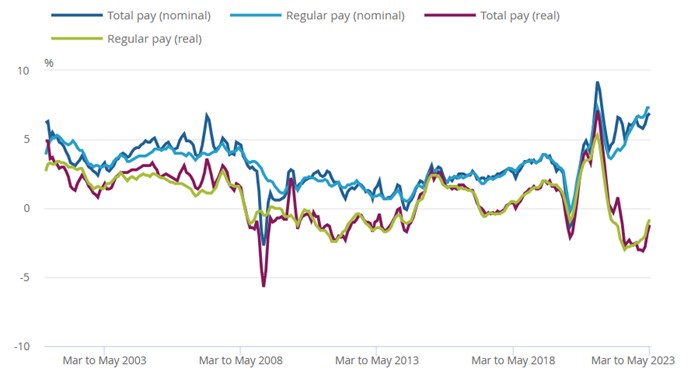ONS Labour Market July 2023
Twelfth consecutive quarterly fall in vacancies
- The number of job vacancies in April to June 2023 was 1,034,000- a decrease of 85,000 from January to March 2023.
- The largest falls in vacancies came from financial and insurance activities, and financial and insurance activities which decreased by 15.3% and 13.4% respectively.
- Real estate activities and mining and quarrying saw strong quarterly growth in vacancies, with increases of 24.8% and 20.0% respectively.
- On an annual basis, total vacancies decreased by 265,000, with accommodation and food service activities experiencing the largest fall (46,000).
- The total number of vacancies remained 232,000 above pre-pandemic levels (January to March 2020).
Fall in retail employees
- Early payroll estimates for June show the number of payrolled employees rose by 439,000 employees compared to the previous year (up 1.5%).
- On the previous month, the number of payrolled employees increased by 9,000, or 0%.
- The largest yearly increase in payrolled employees continued to be driven by health and social work sector (a rise of 209,000 employees YoY), while the smallest was in the wholesale and retail sector (a fall of 47,000).
Inactivity decreasing
- The unemployment rate for March to May 2023 is estimated at 4.0%, 0.2pp higher than the previous three-month period, and has increased to pre-pandemic levels.
- In the quarter, the number of people unemployed for up to twelve months increased, while those unemployed for over twelve months decreased.
- The economic inactivity rate decreased by 0.4pp on the quarter to 20.8% in March to May. Although declining, inactivity is 0.6pp above the pre-pandemic level.
Employment rate edges up
- The employment rate for March to May rose 0.2pp in the quarter to 76.0% but is 0.6pp below pre-pandemic levels.
- The number of full-time employees decreased in the period but remains above pre-pandemic levels. The number of part-time employees also increased in the quarter, driving the increase the employment rate.
- Full-time self-employed workers increased in the latest quarter, while part-time self-employed workers decreased.
Hours worked increases
- Total actual weekly hours worked increased by 4.5 million hours on the quarter to 1.05 billion hours in March to May.
- This is 2.7 million hours above pre-pandemic levels (December 2019 to February 2020). The increase in March to May was driven by both men and women.
Real earnings decline
Both annual total and regular pay growth continued to lag inflation in the three months to May.
- In nominal terms, average regular pay (excluding bonuses) for employees in Great Britain was £607 per week before tax and other deductions from pay in May – up from £604 per week a year earlier.
- Average total pay (including bonuses) for employees in Great Britain was £651 per week before tax and other deductions from pay in May – up from £648 per week a year earlier.
- Regular pay rose by 7.3% and total pay by 6.9% in the three months to May compared to a year earlier. This remains the highest growth for regular pay seen outside the pandemic.
- Average regular pay growth in the private sector was 7.7% in the three months to May, while public sector pay rose by 5.8%.
- In real terms (adjusted for inflation), regular pay and total pay declined 0.8% and 1.2% YoY respectively in the three months to May.
Average weekly earnings annual growth rates in Great Britain, seasonally adjusted, January to March 2001 to March to May 2023

Source: ONS
Back to Retail Economic News